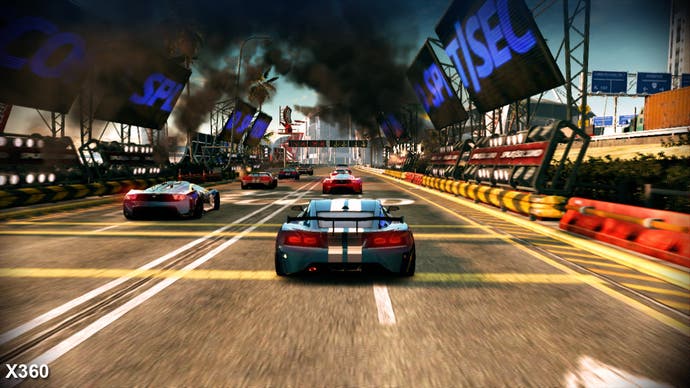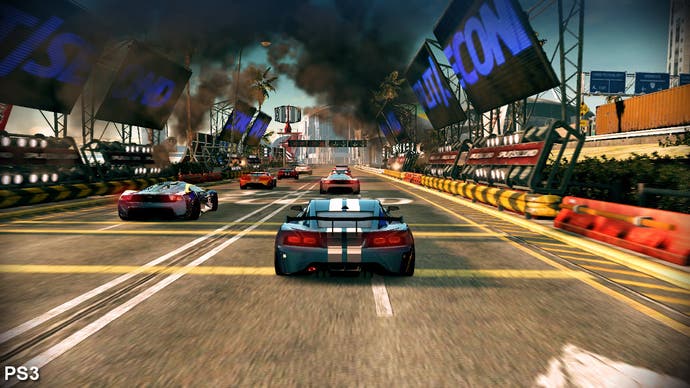Split/Second demo showdown
PS3 and 360 sampler code on the grid.
Probably one of the most criminally overlooked racing games of recent times, Black Rock Studios' Pure was a hugely impressive off-road title, combining ATVs with SSX-style gameplay to produce superb visuals with deeply satisfying gameplay.
Split/Second: Velocity sees an evolution of the excellent tech that powered Pure, brought to us this time in a high velocity Burnout-style of game with a twist: it's not just your opponents on the road you need to do battle with, it's the environment itself. Similar to Burnout, a power meter gradually fills as you perform skillful racing - whether drifting through corners or drafting behind opponents. However, while Burnout concentrated on car-to-car battling, Split/Second opts for a different approach.
Filling up the power bar allows you to detonate areas of the track, causing different routes to open up and environmental hazards to be sent hurtling towards your opposition. The result is a game - and a demo - that offers up a range of different race permutations each time you play, some of which have their own impressive set-pieces. For example, in the demo's airport stage, bringing down the air traffic control tower not only switches the route, but also causes a jet to crash-land on the next lap. Impressive stuff.
Demo content on the PS3 and Xbox 360 versions of the Split/Second demo is exactly the same, offering an insight into how the enhanced Pure engine operates on both consoles. Long-time readers might recall that we said that Pure was "virtually identical" on PS3 and 360, so how does its spiritual successor fare?
Just like Pure, Split/Second operates with a steady 30FPS, with only slight deviation from the standard when the engine is really under stress: the fire effects in particular clearly introduce some small performance issues, for example. In these cases, it's the Xbox 360 build that runs a touch more smoothly. It also exhibits lower levels of screen-tear, though the human eye is unlikely to really tell the difference between the two versions - in this level, at least. Statistically though, in the sample above, Xbox 360 produces around four per cent torn frames while PS3 is at 11 per cent.
Gameplay-wise? The demo code suggests that nobody is going to be disappointed. The technical differences aren't massive, and more importantly, they don't affect the way the game plays: it's solid on both systems. It does look as though post-processing is pared back a touch on PS3, but it also seems to be the case that the 360 version of the game operates with a slightly lower vertical resolution - something like 1280x672 or thereabouts - up against the native 720p on PS3. You can get an idea of how this manifests during gameplay in this comparison shot.


Based on this sampler, Split/Second is looking good and it'll be interesting to see how the PowerPlay "world-changing" concept works in the other stages. Right now our only concern is that there's something of a disconnect between engaging a PowerPlay and causing a building toppling set-piece way down the track. Maybe it's something that will become more natural in the full game but there's an odd sensation that cause and effect don't feel quite as close as they should based on this initial playthrough.
Regardless, the pedigree of Split/Second is beyond doubt. Not only does the game feature Pure tech, but there's a decent array of ex-Criterion Burnout talent working on the game. A proven engine utilised by accomplished developers with a recognised track record in the racing genre? Our hopes are high for this one.


